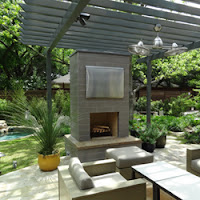Now that Summer is officially over, the days of pool parties, BBQs and entertaining in your outdoor living space is over, right? No! The cool, crisp days of Autumn are actually ideal for having outdoor cook-outs, tailgating for the Game on TV, hanging out around the fireplace and hosting Holiday themed gatherings!
A few tips for extending the use of your Outdoor Living
spaces this Fall:
Design your Outdoor Living Space for versatility
By adding comfortable seating, kitchen elements and, if you have a covered area, a TV, you’ll be able to use your space for multiple activities!
Keep comfort in mind
In addition to comfortable seating, add an Outdoor Fireplace or other fire element for keeping warm after the sun goes down. Additional fun benefits of a fire element include roasting marshmallows, a place to mount your TV for watching the game or a movie and a providing a central gathering place for adults and kids alike.
Fire up your Wood Burning Oven or Grill
Your outdoor kitchen elements are not just for cooking up hamburgers and hotdogs in the Summer months – they can be used year round for delicious treats! In addition to traditional grill fare, a wood burning oven can be especially fun when you have a get-together or party – it can be used for cooking personal pizzas, short ribs, bread and a host of treats and snacks! There are several sources that can be found online for Wood Burning Oven recipes.
Gardens
Provide the fresh veggies and herbs for your outdoor kitchen cooking from your own gardens! Consider growing a couple of Pumpkins for carving or décor instead of using store-bought. Raised garden beds can provide additional seating transform your back yard.
If you haven’t created your Outdoor Living space
yet, then now is the time to start planning! Decide what your primary focal
point (outdoor fireplace, kitchen, wood fired oven, TV or Seating area) and
goal will be (cooking, entertaining, family gatherings, tailgating) and go from
there. There is a huge source online for
design tips, photo
galleries and sites such as Pinterest to
fuel your design juices and helpful articles.
Photo Credits:
Isokern Outdoor Fireplace - Ellen Grasso and Sons in Dallas, TX.
ISO'ven Wood Burning Pizza Oven - Creative Visions, NJ
By: Georgia Fishel
By: Georgia Fishel



